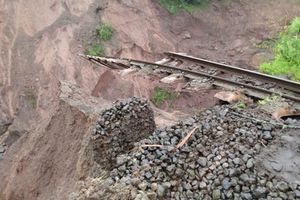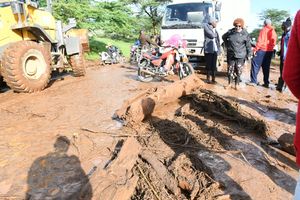
The raging waters of the Kijabe Hills that killed at least 46 people.
The tragedy at Mai Mahiu that killed at least 48 people could have been prevented if government agencies had acted promptly to drain the floodwaters that had collected at the Old Kijabe railway tunnel when the rains started.
An investigation by the Nation can reveal that the tunnel began filling with water the previous week, with some residents being warned of the impending danger.

Residents want the government to construct a dam in the Old Railway area to prevent similar disasters in the future.
According to Zachary Maina, leader of the Nyumba Kumi Initiative in the Old Kijabe area, concerns about the swollen waters were raised early last week, but little action was taken to prevent a disaster.
"We noticed abnormal swelling in the tunnel's waters from Tuesday last week. I immediately informed the area assistant chief and the Member of the County Assembly. Although they tried to warn downstream residents to relocate, their efforts were in vain," Maina told the Nation.
Residents corroborated his account, saying heavy rains made the situation worse before the tragedy occurred on Monday at 3am.
They have also accused government agencies of a sluggish response to what was a disaster waiting to happen.

"There was clear evidence of abnormal swelling in the water trapped at the railway tunnel, yet no attempts were made to drain the tunnel," said Charles Kimani, another resident.
Locals say the tunnel's location and accumulation of silt from the Kinare forest and Kijabe hills contributed to the tragedy.
Authorities have attributed the disaster to heavy rains in the catchment areas of Kinare and Kijabe, leading to the tunnel bursting and washing away debris and several homes.
The floodwaters devastated Jerusalem village, washing away homes, cars, and even large rocks downstream under the cover of darkness.

A section of the destroyed railway.
Residents want the government to construct a dam in the Old Railway area to prevent similar disasters in the future.
"We need the government to build a dam to control the waters from Kijabe hills and prevent such calamities," urged resident Mary Mbuthia.
The Ministry of Water confirmed that the tragedy resulted from the tunnel under the railway embankment becoming blocked with debris, exacerbated by silt from the Kijabe hills and Kinare forest.
“River Tongi and its tributaries burst banks leading to the formation of a huge pool beside the railway line and due to force and pressure exerted, the water eventually swept the railway line and started moving downstream with a very high speed and velocity destroying property and loss of lives," the ministry said in a statement.
Water CS Zachariah Njeru said the only dam in the area, Matches Dam, is in good condition.
“The ministry has reiterated through various communiques that the responsibility of dam owners/operators under Regulation 21 of Water Harvesting and Storage Regulations 2021. All dam owners, contractors, and operators are urged to acquaint themselves and comply with all procedures on dam safety,” CS Mwangi said.
At the site, debris and uprooted trees litter the mud, with animals also succumbing to the fast-flowing waters. The aftermath paints a grim picture, with mud covering the once-standing houses, burying countless lives.
The devastation extended beyond residential areas, affecting motorists on the busy Nairobi-Mai Mahiu road. Their vehicles were swept away, and some were trapped in the mud, while sections of the old Nairobi-Malava rail track and embankment were also washed downhill.
Residents also expressed concern about another nearby tunnel, which they claim released waters that caused a similar tragedy in 1998.
"Government agencies should assess the other tunnel to prevent a repeat disaster," resident John Mbuthia insisted.
Mohamed Shurie, CEO of WARMA, confirmed that the raging waters originated from a deep gully formed by erosion, emphasizing that the nearest dam is approximately 15 kilometers away.












